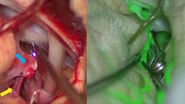Discover the new technologies transforming oncological reconstructive surgery, with the progressive shift to a hybrid Operating Room. Learn about the opportunities each technology offers, and how they can help overcome challenges and limitations, improving the quality of reconstructions.
White Paper table of contents
- Introduction
- Microsurgery evolution: key technological milestones throughout the years
- Oncological reconstructive surgery: surgical assistance technologies improving outcomes
- Ergonomic visualization posture avoiding musculoskeletal problems
- Indocyanine green (ICG) fluorescence to assess anastomosis and flap viability
- Cutting guides and 3D printing improving difficult reconstructions
- AR and high magnification facilitating microsurgery interventions and challenging cases such as lymphoedema surgery
- Full-HD eyepiece image injection for complex microsurgery
- 2D and 3D video recording for training and teaching purposes
- The future of reconstructive surgery: innovations paving the way
- Smart glasses with AR within see-through projection systems
- Robot assistance overcoming human limitations
- Artificial Intelligence for computer-assisted
- decision-making
- Telesurgery remote guidance
- Conclusion
Note: This document contains viewpoints and experiences expressed by Dr. Romain Bosc and do not necessarily reflect the opinion of any institution with whom he is affiliated.
Download the White Paper
Would you like to know more about the innovative solutions and technologies transforming oncological reconstructive surgery and augmenting the surgeon’s abilities? Enter your information below to download our White Paper.






